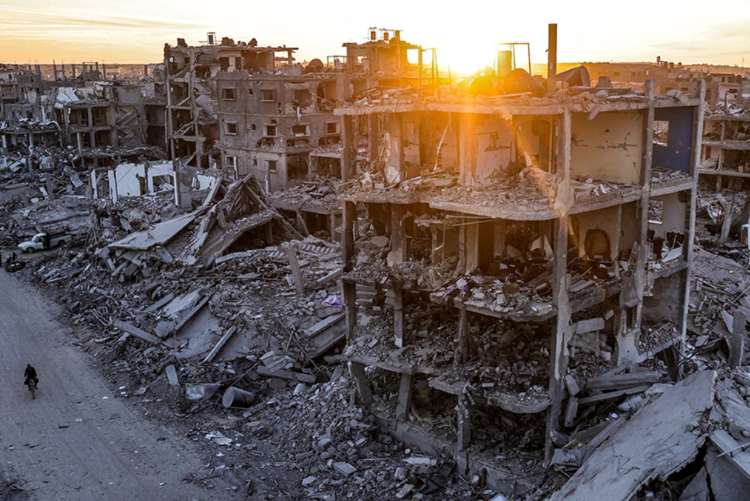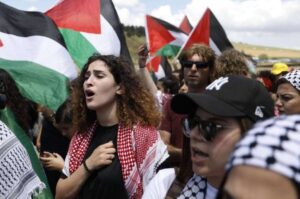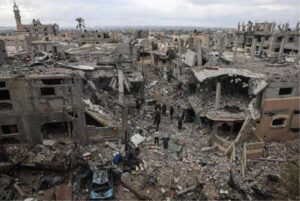
Gaza ceasefire mirage: The announcement that Israel and Hamas have agreed to a “first phase” ceasefire and hostage-prisoner exchange has been hailed as a long-awaited breakthrough in a war entering its third year. Reports of tentative calm have inspired cautious hope that the bombing might end, hostages might return home, and Gaza might begin to breathe again. Yet beneath the rhetoric of relief lies a more complex reality. The ceasefire, though necessary, risks concealing a set of profound dangers — humanitarian, political, military, and legal — that could turn this pause into a prelude to renewed suffering rather than a path to peace.
The Gaza ceasefire offers hope, but that hope rests on fragile foundations. After two years of relentless bombardment that has killed more than 67,000 people, including over 19,000 children, and reduced most of Gaza to rubble, expectations are understandably desperate. Yet the mechanisms underpinning the agreement and the political forces surrounding it suggest that this first phase is more a diplomatic illusion than a durable peace.
READ I India’s electric vehicles push gains global momentum
Aid bottlenecks and famine’s shadow
The most immediate danger is humanitarian stagnation. Ceasefires are supposed to bring relief, but past experience in Gaza shows that aid often remains tightly controlled or politicised. During earlier pauses in hostilities, Israel marginally loosened restrictions but continued to block critical materials such as heavy equipment, cement, and fuel — items indispensable for rebuilding hospitals and water systems. Medical evacuations, too, were limited by arbitrary quotas, leaving many patients stranded inside the besieged enclave.

Today, the humanitarian crisis is almost beyond comprehension. According to The Lancet, more than 54,000 children under five suffer from acute malnutrition, including nearly 13,000 with severe acute malnutrition. UN agencies warn that the famine enveloping northern Gaza is “entirely man-made,” the result of persistent restrictions on food, medicine, and fuel. The risk is that the ceasefire will merely stabilise this misery — keeping Gazans alive but trapped in dependency — without restoring livelihoods or dignity. Aid convoys and photo opportunities cannot substitute for a functioning economy or access to clean water, health care, and shelter.
Political vacuum: A ceasefire without a state
The political vacuum that the Gaza ceasefire risks freezing into permanence can lead to flare-ups. No truce can endure if it does not resolve the question of governance — who will rule Gaza, how authority will be shared, and how reconstruction will be managed. The deal reportedly envisions Israeli withdrawal to “agreed lines” and the creation of a transitional administrative structure, but details are scarce. Without clarity, the territory may descend into competing power centres: remnants of Hamas, elements of the Palestinian Authority, local militias, or foreign monitors with limited legitimacy.

This ambiguity is not accidental. As analysts note, Israel’s leadership continues to pursue the illusion of total victory — seeking to dismantle Hamas militarily while retaining de-facto control of the enclave. The ceasefire may thus become a cover for reoccupation by other means. Meanwhile, external donors debating reconstruction assistance may impose political conditions that effectively dictate Gaza’s post-war governance. For a displaced and traumatised population, this would mean not liberation but renewed subjugation under an imposed order.
Security relapse: The ceasefire as a fault line
There is also a likelihood that the Gaza ceasefire may not hold. Truces in the Gaza conflict have rarely been honoured for long. During the most recent temporary pause, Israeli forces carried out over 200 violations—drone strikes, shelling, and incursions—before hostilities resumed in full. Reports suggest that Prime Minister Benjamin Netanyahu faces intense pressure from far-right ministers who view any ceasefire as capitulation. A single provocation — real or fabricated — could unravel the deal within days.
Nor is Hamas immune from the temptation to exploit a lull for regrouping. If oversight is weak, the movement could rebuild its command networks, replenish munitions, and reinforce tunnels, perpetuating the very cycle of militarisation that Israel cites to justify its siege. Regional actors, too, may act as spoilers, funnelling weapons or political support to factions unwilling to compromise. Thus, the ceasefire is not a bridge to peace but a fault line running through an already fractured landscape — liable to rupture under the slightest pressure.
Justice deferred, accountability denied
The most insidious danger is the erosion of accountability. The humanitarian catastrophe in Gaza has been described by a United Nations commission as a genocidal campaign, an accusation Israel rejects. Whether or not the charge is upheld, the scale of destruction — over 90 per cent of homes damaged, hospitals obliterated, entire families erased—demands a serious reckoning. Yet ceasefires, if poorly designed, can become mechanisms for forgetting.
A Gaza ceasefire that halts fighting without establishing a credible process for documenting war crimes or preserving evidence risks normalising impunity. As Global Centre for the Responsibility to Protect warns, the danger of further atrocities remains high even during apparent calm. In the name of reconstruction, evidence may be bulldozed, witnesses silenced, and archives destroyed. Survivors of hospital raids, forced displacement, and starvation may find their pleas subsumed under the rhetoric of rebuilding. The result is a cruel paradox: a ceasefire that halts the violence but cements the conditions for its repetition.
Beyond the mirage: Building a durable peace
To acknowledge these risks is not to dismiss the value of a Gaza ceasefire. The people of Gaza deserve immediate respite from bombardment, access to food and medicine, and the chance to mourn and rebuild. But a truce must be more than a pause in the killing; it must be the first step in a sequence of reforms that prevent recurrence.
That requires transparent and verifiable monitoring by neutral parties, with real-time reporting of Gaza ceasefire violations and consequences for breaches. It also demands unconditional humanitarian corridors that allow not only food and medicine but also machinery for clearing rubble and rebuilding essential infrastructure. Equally vital is a credible interim governance framework that empowers Palestinian institutions rather than external overseers, coupled with an agreed timeline for political transition.
Security arrangements must be insulated from domestic politics on both sides, ensuring that hardliners cannot derail the process through provocation or unilateral action. Above all, the ceasefire must incorporate an independent accountability mechanism—an international commission with authority to investigate war crimes, preserve evidence, and ensure reparations for victims before reconstruction contracts are signed. Without justice, no peace will endure; without accountability, every truce is temporary.
If these safeguards are neglected, the so-called Phase-One ceasefire will remain a diplomatic mirage—an exercise in image management that stabilises the conflict rather than resolves it. True peace will not come from managed pauses or carefully worded communiqués but from a moral reckoning with the scale of destruction and the recognition of Palestinian rights long denied.
Only then can Gaza’s battered land truly breathe again—not as a hostage to geopolitics, but as a society restored to life, law, and dignity.
Anil Nair is Founder and Editor, Policy Circle.

